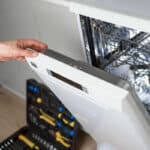Do you have a broken washing machine? Perhaps the spin cycle doesn’t work, or the washer won’t turn on. Fortunately, some simple troubleshooting tips and tricks can help resolve the issue.
Here are a few common problems associated with a broken washing machine and how to troubleshoot them. You can find more detailed information specific to your washing machine in the owner’s manual.
But before we begin, if your washer is under warranty, you will probably need the help of a Colorado Springs washing machine repair technician to troubleshoot and repair a broken washing machine. If you do the work yourself, you’ll risk voiding the warranty, and you’ll be financially on the hook for any further repairs.
Your Washing Machine Is Making Strange Noises
One reason homeowners may think they have a broken washing machine is that they hear a funny noise during the washing cycle. If this happens to you, make a note of when the noises occur during the cycle. For example, a noticeable noise during or after the spin cycle indicates a problem with the drain pump. This pump drains the water from the tub during and after the spin cycle. A noisy drain pump suggests either a clog is present, restricting drainage, or that the pump itself is faulty.
Front-loaded washing machines have shock absorbers that limit the tub movement inside the machine. If these shock absorbers are damaged or become worn out, you’ll hear loud banging sounds during the spin cycle. If this is the case, you will need to replace the shock absorbers. Neglecting the shock absorbers on your washing machine can cause damage to other components.
If your washing machine seems to be louder and shaking more than usual, check out our article How to Make a Washing Machine Stop Shaking. The simple step of ensuring your load is balanced may solve your issue.

Washing Machine Leaks
Leaks in your washing machine are a relatively straightforward problem to troubleshoot.
The two main culprits of washing machine leaks are the drain and fill hoses. The drain hose drains the water out of the machine before the spin cycle, and the fill hose brings water into the tub before the wash cycle.
The fill hoses are usually located on the rear of the machine and connect to your house’s water supply. Scrutinize the hose, ensuring that all connections are tight and secure and there are no cracks or holes.
There are also drain hoses on the back of the washing machine, and you should perform the same inspection you did on the fill hose. However, you’ll also need to inspect where your drain hose connects to your home’s drain. If there’s a clog in the house drain, water can back up into the drain hose.
Of course, there is also the possibility of user error when your washing machine leaks. If you overfill a top-loading washing machine, water entering the tub will spill over and leak out of the side of the machine. This is not necessarily an indication that you have a broken washing machine.
Your Washing Machine Will Not Start
Nothing is more aggravating than getting a load of laundry ready and having the washing machine refuse to start. If this happens to you, start with the obvious. First, ensure that the switch/knob on the control panel is in the appropriate setting.
Second, confirm that the start button is firmly pressed.
Third, check that the door or lid is completely closed and that the door lock is working correctly. As a safety feature of most modern washing machines, if either one of those components is malfunctioning, the machine will not start.
Ask For Help
Some of the problems listed above are more complex than others. Because modern washing machines are more digital than ever, it’s almost always a good idea to call a certified repair technician if you have a broken washing machine. Most of these appliances contain delicate circuitry that is typically beyond the average homeowner’s skill set. The last thing you want to do is void the warranty or make the problem worse.
Schedule an appointment with a washing machine repair technician today.




